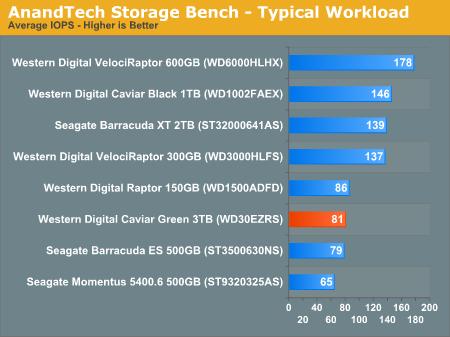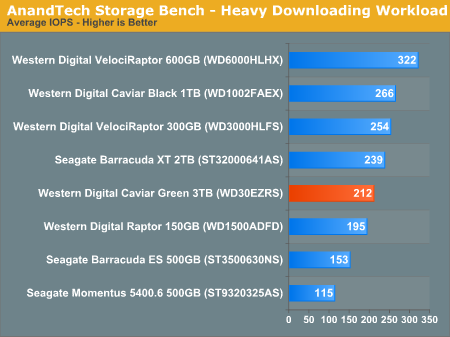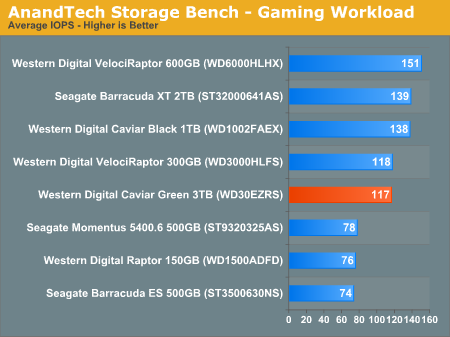Western Digital Caviar Green 3TB and My Book Essential 3TB Drives Reviewed
by Anand Lal Shimpi on October 19, 2010 1:43 PM EST- Posted in
- Storage
- HDDs
- Western Digital
- 3TB
AnandTech Storage Bench
The first in our benchmark suite is a light usage case. The Windows 7 system is loaded with Firefox, Office 2007 and Adobe Reader among other applications. With Firefox we browse web pages like Facebook, AnandTech, Digg and other sites. Outlook is also running and we use it to check emails, create and send a message with a PDF attachment. Adobe Reader is used to view some PDFs. Excel 2007 is used to create a spreadsheet, graphs and save the document. The same goes for Word 2007. We open and step through a presentation in PowerPoint 2007 received as an email attachment before saving it to the desktop. Finally we watch a bit of a Firefly episode in Windows Media Player 11.
There’s some level of multitasking going on here but it’s not unreasonable by any means. Generally the application tasks proceed linearly, with the exception of things like web browsing which may happen in between one of the other tasks.
The recording is played back on all of our drives here today. Remember that we’re isolating disk performance, all we’re doing is playing back every single disk access that happened in that ~5 minute period of usage. The light workload is composed of 37,501 reads and 20,268 writes. Over 30% of the IOs are 4KB, 11% are 16KB, 22% are 32KB and approximately 13% are 64KB in size. Less than 30% of the operations are absolutely sequential in nature. Average queue depth is 6.09 IOs.
The performance results are reported in average I/O Operations per Second (IOPS):

Real world drive performance is a bit of a letdown if you're planning on using the 3TB drive as a boot drive. It's barely any faster than an old Seagate Barracuda ES and even slower than the old 150GB VelociRaptor.
If there’s a light usage case there’s bound to be a heavy one. In this test we have Microsoft Security Essentials running in the background with real time virus scanning enabled. We also perform a quick scan in the middle of the test. Firefox, Outlook, Excel, Word and Powerpoint are all used the same as they were in the light test. We add Photoshop CS4 to the mix, opening a bunch of 12MP images, editing them, then saving them as highly compressed JPGs for web publishing. Windows 7’s picture viewer is used to view a bunch of pictures on the hard drive. We use 7-zip to create and extract .7z archives. Downloading is also prominently featured in our heavy test; we download large files from the Internet during portions of the benchmark, as well as use uTorrent to grab a couple of torrents. Some of the applications in use are installed during the benchmark, Windows updates are also installed. Towards the end of the test we launch World of Warcraft, play for a few minutes, then delete the folder. This test also takes into account all of the disk accesses that happen while the OS is booting.
The benchmark is 22 minutes long and it consists of 128,895 read operations and 72,411 write operations. Roughly 44% of all IOs were sequential. Approximately 30% of all accesses were 4KB in size, 12% were 16KB in size, 14% were 32KB and 20% were 64KB. Average queue depth was 3.59.

The more sequential the workload, the more the Caviar Green is going to behave like a normal high performance drive. In this case we're very close to the performance of Seagate's 7200RPM Barracuda XT 2GB (and presumably the upcoming 3TB version). The strong showing here is due to Western Digital's high areal density.
The gaming workload is made up of 75,206 read operations and only 4,592 write operations. Only 20% of the accesses are 4KB in size, nearly 40% are 64KB and 20% are 32KB. A whopping 69% of the IOs are sequential, meaning this is predominantly a sequential read benchmark. The average queue depth is 7.76 IOs.

Read performance is decent, but a good 7200RPM drive will still be a bit faster. The 3TB Caviar Green will serve as a good place to store movies, music and photos but if you're a gamer concerned about load times you might want to stick with a 7200RPM drive.










48 Comments
View All Comments
mapesdhs - Wednesday, October 20, 2010 - link
I've been buying Samsung drives for a while, they are indeed pretty quick. I've
not compared to Seagate or WD, but I've added some Samsung HDTach data to
my benchmarks page for the 1TB editions of the Spinpoint F1 and F3, if it's of
any use:
http://www.sgidepot.co.uk/diskdata.html
At some stage I'd like to start testing random read/write with IOMeter, but finding
the time is a problem.
Ian.
EddyKilowatt - Tuesday, October 19, 2010 - link
Exactly. I think the fast/high performance end of the magnetic storage market will wither pretty fast under the onslaught of SSDs, except for increasingly niche applications that need fast access to 500-1000 MB of data.Meanwhile, as SSDs get solidified in the fast boot/app/cache role, the need for speed will further be relaxed for these big TB-class drives, and disk builders will feel freer to optimize for areal density at the expense of speed. I think we'll see lots of 5400 drives, and who knows... maybe 4200 and other speeds that till now have seemed like grandma territory. Anything that can originate a couple of full-HD video streams, or other media stream of your choice, seems like it ought to be viable for what will increasingly be the foundation tier of the ever-diversifying storage hierarchy.
AFUMCBill - Tuesday, October 19, 2010 - link
"The Essential suffix somehow implies USB 3.0 support."This is incorrect. The Essential suffix means USB only support, no eSATA, no FireWire. That USB support can be either USB 2.0 or USB 3.0.
kepstin - Tuesday, October 19, 2010 - link
It's not actually true that a classic PC BIOS can't boot from a GPT formatted disk - I'm doing that right now!The design of GPT incorporates backwards compatibility, including space for an old-fashioned MBR boot sector that can be loaded with a bootloader that knows how to read GPT. As a result, Linux boots just fine on a GPT partitioned disk, even on a classic BIOS PC.
The issue is specifically that Windows can't boot off of a GPT disk without EFI, because the boot loader that Windows uses on a BIOS machine doesn't know how to read GPT partitions.
Mr Perfect - Wednesday, October 20, 2010 - link
Can it read more then 2TB? I read it to mean that BIOS couldn't handle anything bigger then 2TB, regardless.Etern205 - Wednesday, October 20, 2010 - link
On page 2 , one of the images show a MBR partition HDD can be converted to GPT.If one has all the requirements, can they just use their OS disc to directly create a GPT partition instead of doing this conversion stuff?
R3MF - Wednesday, October 20, 2010 - link
Anand - will there be 2TB green drives based on these platters?tiro_uspsss - Wednesday, October 20, 2010 - link
there is no 150GB VelociRaptor in the benches/review.. ;)mapesdhs - Wednesday, October 20, 2010 - link
Here's what I get with HDTach for my WD VR 150GB:
Max: 132.0 MB/sec
Avg: 107.0 MB/sec
Min: 79.0 MB/sec
Burst: 248.0 MB/sec
Access: 6.9ms
Ref: http://www.sgidepot.co.uk/diskdata.html
What does IOMeter use as its definition of 1MB? 10^6 bytes or 2^20 bytes? I think
HDTach uses the former.
Ian.
Mr Perfect - Wednesday, October 20, 2010 - link
I've seen a number of sites now mentioning UEFI will show up in H1 of 2011. Is UEFI an official feature of the Cougar Point chipsets?